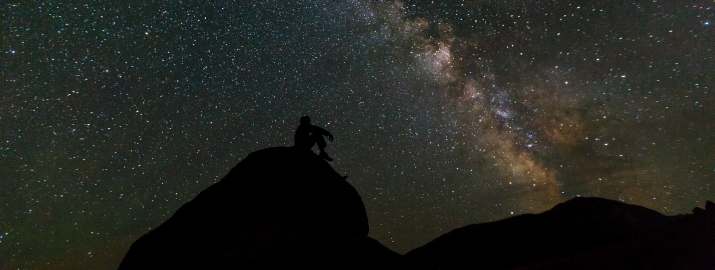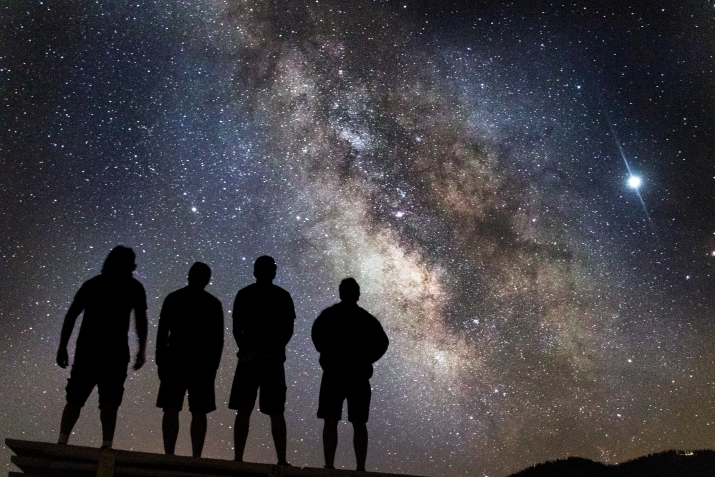
16 Best Stargazing Places Around the World
Table of Contents
Due to air pollution, population density, and city lights, it is almost impossible to see the stars in the sky with the naked eye. You can only see night skies as tiny glows. However, lying under the stars at night and watching the shooting stars allows you to experience unforgettable moments. You don’t even realize how time flies when you are guessing the names of the constellations or trying to locate the Pole Star.
Since its foundation in 1988, the International Dark-Sky Association (IDA) has recognized many stargazing sites in different parts of the world, working to reduce light pollution and protect the skies. These places include national parks, deserts, nature reserves, and mountains.
In this article, we’ll look at the best stargazing places in the world. In many parts of the world, from America to Japan, there are places where you can see the stars in their clearest form. It is also possible to stay in many of these places, allowing you to connect with the sky through promotional tours, lessons, and events. Read on if you’re looking for a place to see the stars at their best.

Best Stargazing Spots: 16 Locations Around the World
1. Natural Bridges National Monument, Utah, United States
The exciting feature of the Natural Bridges National Monument in Utah is that it reveals the “river of light” form as the Milky Way rises over the Owachomo Bridge. This way, you can see thousands of stars with the naked eye. You can have an unforgettable experience thanks to the possibility of camping options in the region. The Monument is a frequent destination for night photographers who want to photograph extraordinary stars. However, keep in mind that the use of artificial lights to take pictures is prohibited. Thanks to its efforts to protect and conserve darkness, the Monument has become the first certified International Dark Sky Park awarded by the International Dark-Sky Association, the leading organization to combat light pollution.
Additionally, another stargazing location close to Natural Bridges National Monument is Bryce Canyon National Park in Utah.
2. Atacama Desert, Chile
The Atacama Desert, the most popular spot for Astro-tourism in the world, is one of the ideal stargazing spots. The Atacama Desert stands out thanks to its three most essential features: These are unpolluted skies, high altitude, and low precipitation. Also, the Atacama Desert hosts the ALMA Observatory, which has 66 of the world’s most powerful radio telescopes. Another feature that attracts many observers to the region is the accommodation options in the Elqui Valley, located at the foot of the desert. For example, hotels like Elqui Domos offer accommodation in wooden cabins with glass roofs and domed tents with open ceilings. There are also stargazing guides in the region. The broader Atacama-Elqui area in northern Chile is the best location in the world for stargazing because of its low rainfall, elevation, and low light pollution.

3. Mauna Kea, Hawaii, United States
The highest point in Hawaii and the inactive Mauna Kea volcano offer a unique experience in terms of stargazing. Mauna Kea, among the world’s highest mountains, is approximately 4,207 meters above sea level. Although it carries risks due to its high altitude and low oxygen level, it is visited by sky lovers. At Mauna Kea, which has the world’s largest optical telescope, visitors are given free lessons, and special tours are organized with telescopes before they reach the summit. Afterward, visitors continue to the peak with a guided tour or with their private vehicles.
4. Aoraki Mackenzie International Dark Sky Reserve, New Zealand
Aoraki Mackenzie International Dark Sky Reserve in the Mackenzie Basin on New Zealand’s South Island is one of the largest dark sky reserves in the world. The Reserve was established in 2012 to study light pollution-free and pristine skies. Astro-tourism is also highly encouraged in the Reserve, where astronomical research continues. Researchers from the Reserve, the world’s southernmost astronomical observatory, study and observe the Magellanic Clouds, the Galactic Center, binary stars, extrasolar planets, and more.
5. NamibRand Nature Reserve, Namibia
The NamibRand Nature Reserve is around 96 square kilometers from the nearest village, and the Reserve is located in the Namib Desert. It is called “one of the darkest places in the world” by the International Dark-Sky Association because it is quite far from settlements. It is also the first Reserve to achieve Gold Tier status, the Association’s highest award. Visitors can hike up the dunes by camping in the Namib Desert and taking guided tours. In addition, the Namib Desert Environmental Education Trust (NaDEET) Center organizes environmental educational programs, especially for local students.

6. Tenerife, Canary Islands, Spain
Another stargazing area where you can enjoy the darkest and clearest skies is Tenerife in the Canary Islands. Its proximity to the equator, distance from tropical storms, and high altitude make it suitable for sky observation. In addition, a law has been passed in Tenerife that controls the routes of flights so that the conditions for stargazing don’t deteriorate. Another highlight of Tenerife is that it hosts the semi-annually Starmus Festival. Festival attendees enjoy the area with space-themed parties, lectures, and screenings. Participants, that included Stephen Hawking and Neil Armstrong in the past, can also visit the Teide Observatory from April to December and watch the stars from the top of the volcanic Mount Teide.
7. Sagarmatha National Park, Nepal
Home to Mount Everest, the highest mountain in the world, Sagarmatha National Park is also frequented by observers who come to watch the stars. While watching the stars from Sagarmatha National Park is beautiful, it is equally difficult to reach the region. Many trails within the National Park get closer to the mountain peaks. There is also a forested area at lower altitudes with views of the star-filled sky and Mount Everest.
8. Kerry International Dark Sky Reserve, County Kerry, Ireland
Covering an area of 700 square kilometers and nine sites, the Kerry International Dark Sky Reserve has provided impressive, pristine clear skies since 2013. Events, community projects, and excursions are organized in the Reserve, where Astro-tourism is supported. There are many local-owned accommodations and campgrounds within the Reserve for skywatchers to stay in. In addition, star observation guidance is provided by experienced astronomers.

9. Iriomote-Ishigaki National Park, Okinawa, Japan
Iriomote-Ishigaki National Park, Japan’s first International Dark Sky Places accreditation, is also the second Sky Place in Asia. The Park, where 84 of the 88 constellations recognized by the International Astronomical Union can be observed, is close to the Tropic of Cancer. Stargazing times vary depending on weather conditions. In addition, another important element of the Park is the habitat of the Iriomote wildcat.
10. Kruger National Park, South Africa
Kruger National Park in South Africa is among the most significant natural areas in the world. Covering an area of approximately 19,485 square kilometers, it is also South Africa’s first national park. Its distance from residential areas and the absence of light pollution provide an impressive sky viewing experience. Visitors to Kruger National Park have to add an overnight astronomy trip to their schedule as they come to see the famous Big Five (leopards, lions, elephants, buffaloes, and rhinos). There are also luxury safari lodges for visitors to stay in.
11. New Mexico True Dark Skies Trail, United States
A special place for space exploration, New Mexico is also a frequently preferred place for stargazing. It offers the world’s best sky observation opportunities thanks to its low population density, high altitudes, clear skies, and dry climate. It is also home to the Gold and Silver-tier Dark Sky Parks. Besides watching Venus, Mercury, and the Milky Way, you can even observe many constellations and zodiacal lights. Campsites, monuments, and parks on the True Dark Skies Trail, the Northern Hemisphere’s first International Dark Sky Sanctuary, are also open to visitors.

12. Pic du Midi, French Pyrenees, France
Pic du Midi, where NASA scientists took photographs of the Moon’s surface, is in the French Pyrenees. In Pic du Midi, which also offers unforgettable experiences for observers, you can take a cable car to the summit where the observatory is located on the top of the mountain. There are also accommodations where visitors can stay and sleep under the stars.
13. Denali National Park Reserve, Alaska, United States
Home to Mount Denali, the highest peak of the North American continent, Denali National Park Reserve has an area of 5,430 square kilometers. The area with a clear sky is quite far from noise and light pollution. Besides the natural scenery of the National Park, visitors are encouraged to watch the night sky and see the Aurora Borealis, aka Northern Lights. If you want to watch the stars for a longer time, you should visit the Reserve during the spring, autumn, and winter months when the night is longer.
14. Uluru, Australia
Australian natives have studied the stars’ movements for many years to calculate hunting periods and harvest times. They are said to be almost the first astronomers. With minimum light pollution and low humidity, Australia is one of the best places to watch stars. Uluru Rock, also known as Ayers Rock, is in Uluru-Kata Tjuta National Park. Towards sunset, skywatching tours begin with a brilliant display of fire-colored rocks. After examination of the iconic dunes, visitors are guided for sky observation. Especially for astronomy enthusiasts, the Uluru tour will be quite enjoyable.
15. Kakslauttanen Arctic Resort, Finland
Through a glass igloo, you may view the Northern Lights at Kakslauttanen Arctic Resort in Finland. There are heated glass igloos with individual restrooms or basic “snow” igloos covered in snow. Each of the new Kelo-Glass igloos has a separate sauna and fireplace and is connected to a wooden hut. You can see the lights as they dance across the sky.
16. Cherry Springs State Park, Pennsylvania
Particularly in Cherry Springs State Park, the stars in Potter County appear to sparkle much brighter! Cherry Springs State Park is one of the greatest locations along the Eastern Seaboard for astronomy because of its extraordinarily black sky. From April through October, weekend programs are conducted, attracting hundreds of visitors to enjoy this special resource. For the most recent information, visit the park site or the stargazing pages.
The Bottom Line
There you have it. We’ve given you a list of the best stargazing sites that are worth discovering thanks to distance from settlements, striving for dark skies, and high altitude. From the Atacama Desert to the Natural Bridges National Monument in Utah, there are many places to see the stars at their best. The purpose of many stargazing places with different conditions in Africa, Europe, Asia, or America is to protect the sky and reveal the planet. These places, many of which are recognized and supported by the International Dark-Sky Association, also take various measures to reduce light pollution. For example, in Tenerife, there is even a law regarding flight controls so that the sky is not damaged. We must continue our support of these stargazing places in order to better know and protect our planet.
From Europe to Australia, almost every corner of the world has a suitable area for a nice stargazing experience. Each stargazing area has its style. If you want to see the stars in their most beautiful form and contribute to Astro-tourism, choose the most suitable place for you.
Frequently Asked Questions for Best Stargazing Places
Where is the clearest sky on Earth?
Many of the stargazing sites have clear skies. The Atacama Desert has a very high and dry sky, is far from settlements, and has little light pollution. For this reason, we can put the Atacama Desert first in the cleanest sky ranking.
Which country can see the Milky Way?
You can see the Milky Way from many countries, especially in America. You can also see the Milky Way well in Chile, Canada, Spain, Italy, New Zealand, and the Atacama Desert.
Where is the best stargazing in the US?
Natural Bridges National Monument in Utah and Mauna Kea in Hawaii top the list of top stargazing destinations in America. Also, Bryce Canyon National Park in Utah and Big Pine Key in Florida are very popular stargazing destinations.
Where is little to no light pollution?
Many areas seen among stargazing locations are struggling with light pollution and are protected. The Kruger National Park, the Atacama Desert, and Tenerife on the Canary Islands are among these.
What state has the clearest skies?
New Zealand is one of the countries with the clearest skies. In particular, Aoraki Mackenzie International Dark Sky Reserve has the darkest and clearest skies.
Where is the best place to see the Milky Way?
The New Mexico True Dark Skies Trail and Natural Bridges National Monument in the US are the best places to watch the Milky Way.
What state can you see the most stars in?
The US, New Zealand, South Africa, and Spain top the list of places where you can see the stars best.

